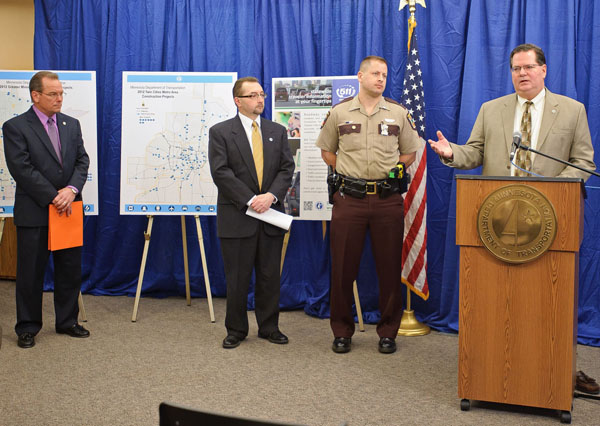
(From left) Bernie Arseneau, deputy commissioner and chief engineer; Commissioner Tom Sorel; and Lt. Eric Roeske, Minnesota State Patrol; join Tom O’Keefe, Metro District director of program delivery, at a news conference announcing the 2012 state road construction program. Photo by David Gonzalez |
State transportation officials gathered at Central Office April 5 to officially announce the beginning of the 2012 construction season.
This year’s program consists of 316 projects around the state with a construction cost of nearly $920 million.
“MnDOT is focused on improving our highways and maximizing the capacity of the system," said Commissioner Tom Sorel. “Our transportation system is vital to the state’s economy and to its citizens’ quality of life. We want to ensure that it provides a safe and efficient trip for all users.”
This year’s state highway construction projects include work on the Interstate 694/Hwy 10 interchange in the Twin Cities and the conclusion of bridge and pavement replacement on a section of I-35 in Duluth. Other projects scheduled for 2012 improve safety at railroad crossings, repair seawalls and docks and make improvements on runways and terminals at regional airports.
“This year’s program will also aid the state’s economy by supporting thousands of jobs this year,” Sorel said. “The highway construction industry employs thousands and is a key partner in our efforts to deliver this program.”
Unlike past years, the kickoff news conference aired statewide via webinar, giving media in Greater Minnesota a better opportunity to ask district representatives questions about local projects that are part of the 2012 program.
Some districts will be working on their largest construction programs to date this year, including District 1, where a $180 million price tag marks the highest ever in the district’s history. District 1 construction programs since 2007 have ranged from $60 million to $125 million, according to Mike Tardy, District 1 assistant district engineer. The size of the 2012 program is primarily due to the inclusion of additional funding to regular state and federal funds, including:
- $50 million for Better Roads for a Better Minnesota projects
- $45 million for high priority projects
- $7 million for a federal forest highway project
- $2 million for a Chapter 152 bridge project
“Also, there is approximately $8 million worth of work from last year that had to be carried into this year due to the state government shutdown,” Tardy said. “Add it all up, and it's a record construction year for District 1.”
Additional projects this year in Greater Minnesota include:
- Constructing an interchange on Hwy 14 in North Mankato.
- Resurfacing portions of Hwy 10 between Clear Lake and Big Lake.
- Resurfacing 28 miles of Hwy 71 in Koochiching County.
Metro District also will be working on a large construction program that features 93 separate road and bridge projects, including the continuation of the $130.4 million Hwy 52 Lafayette Bridge in St. Paul.
In addition to large projects like the Lafayette Bridge, Metro District will be working on several innovative projects around the Twin Cities aimed at minimizing traffic impacts and improving the quality of life for the traveling public. One of those projects is the Maryland Avenue Bridge over I-35E in St. Paul.
“For Maryland Avenue, we're using a technology called a self-propelled modular transporter,” said Tom O’Keefe, Metro District director of program delivery. “What that allows us to do is build the bridge deck and superstructure offline and then move that into place at the end of construction.”
Building the bridge at a different location reduces the amount of time Maryland Avenue will need to be closed, which will be “no more than 60 days,” according to O’Keefe.
Another technology being used by Metro District this year is a moveable barrier—a large machine used to transfer concrete barrier segments from one road surface to another. The moveable barrier has been used before on the I-94 bridge between Minnesota and Wisconsin, and will be used this year on I-494 in Bloomington to reduce traffic impacts.
Additional projects this year in the Twin Cities metro area include:
- Continuing work on the Hwy 61 Mississippi River bridge in Hastings.
- Resurfacing I-35E between St. Paul and Forest Lake.
- Continuing work on the Hwy 169 and I-494 interchange.
For a complete list of projects, including construction dates and traffic impacts, visit www.dot.state.mn.us/construction.
To view a video recording of the construction kickoff news conference, visit http://mediasite.uvs.umn.edu/Mediasite/Viewer/?peid=0d08a7527a844c319f34d720dddac82d.
|



